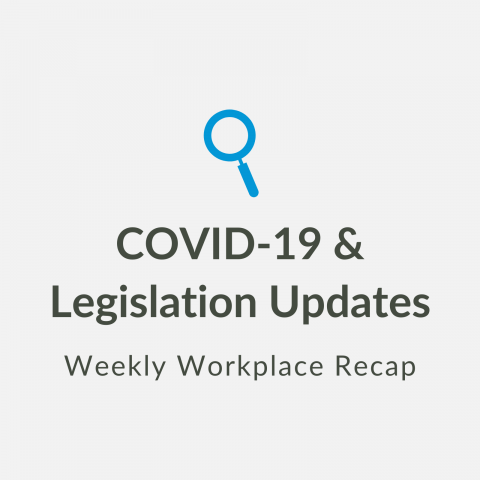Federal
CPP premiums set to rise in January, a bigger jump than planned
Like last year, CPP contributions are going up again by more than originally planned, and the reason again lies with the unique impacts of the pandemic on the labour market.
A KPMG note in November said the maximum employer and employee contributions will hit $3,499 each in 2022, an increase from $3,166 this year. For self-employed contributions, the maximum amount will be $6,999, up from $6,332.
For 2022, the earnings ceiling, known as the yearly maximum pensionable earnings or YMPE, was supposed to be $63,700, an increase of $2,100 from the 2021 limit. But the actual amount is going to be higher at $64,900, for a 5.3% increase, which is the largest in three decades.
News Release
Applications now open for expanded CWLB
Expanded access to the Canada Worker Lockdown Benefit (CWLB) is now in effect.
Previously announced in December, the program now includes workers in regions where provincial or territorial governments have introduced capacity-limiting restrictions of 50% or more.
The benefit will provide $300 ($270 after taxes withheld) per week in income support to eligible workers who are directly affected by a COVID-19-related public health lockdown, and who have lost 50% or more of their income as a result. Payment will be retroactive to Dec. 19, 2021.
Canadians in designated regions affected by lockdowns or qualifying capacity restrictions can apply for the benefit.
News Release
Ottawa clarifies ROE rules for vaccine-related dismissals
Ottawa has clarified the rules when it comes to records of employment (ROEs) and vaccine mandates. The government is providing additional information to that provided in October.
If employees are directly affected by a lockdown as a result of COVID-19 and they’re no longer working, employers must issue an ROE.
And in a Dec. 24 update, the federal government confirmed that:
- When the employee is no longer working due to a shortage of work because the business has closed or decreased operations due to a lockdown as a result of COVID-19, employers should use code A (shortage of work)
- When the employee is sick or quarantined, they should use code D (illness or injury) as the reason for separation (block 16)
- When the employee refuses to come to work but is not sick or quarantined, use code E (quit) or code N (leave of absence), as appropriate.
- When an employer suspends or terminates an employee for not complying with a mandatory COVID-19 vaccination policy, it should use code M (dismissal or suspension).
Access further, updated EI information for employers here.
Ontario
Ontario increases minimum wage to $15 an hour
The Ontario government has raised the general minimum wage to $15.00 per hour. As of January 1, 2022, the following wages are in place in Ontario:
- General minimum wage workers are now earning $15.00 per hour, a raise from $14.35.
- Liquor servers have received a pay raise from $12.55 to $15.00 per hour.
- Students under the age of 18 who work 28 hours a week or less when school is in session or work during a school break or summer holidays, had their pay raised from $13.50 to $14.10 per hour.
- Homeworkers (those who do paid work out of their own homes for employers) had their pay raised from $15.80 to $16.50 per hour.
- Hunting, fishing and wilderness guides had their pay raised from $71.75 to $75.00 when working less than five consecutive hours in a day, and $143.55 to $150.05 when working five or more hours in a day.
News Release
Ontario temporarily moving to modified step two of the Roadmap to Reopen
The Ontario government is temporarily moving the province into Step Two of its Roadmap to Reopen with modifications that take into account the province’s successful vaccination efforts.
These measures include, but are not limited to:
- Reducing social gathering limits to 5 people indoors and 10 people outdoors.
- Limiting capacity at organized public events to 5 people indoors.
- Requiring businesses and organizations to ensure employees work remotely unless the nature of their work requires them to be on-site.
- Limiting capacity at indoor weddings, funerals, and religious services, rites and ceremonies to 50% capacity of the particular room.
- Retail settings, including shopping malls, permitted at 50% capacity.
- Closing indoor meeting and event spaces with limited exceptions but permitting outdoor spaces to remain open with restrictions.
- Closing indoor dining at restaurants, bars and other food or drink establishments. Outdoor dining with restrictions, takeout, drive through and delivery is permitted.
- Closing indoor concert venues, theatres, cinemas, rehearsals and recorded performances permitted with restrictions.
Please view the regulation for the full list of mandatory public health and workplace safety measures.
News Release
Alberta
Alberta sets new isolation and related masking requirements
The CMOH Order 01-2022 sets out isolation and related masking requirements in Alberta.
Effective January 3, Albertans are legally required to isolate as outlined below:
- Fully vaccinated (2 doses or 1 dose Janssen): Isolate for 5 days from the start of symptoms or until they resolve, whichever is longer, if symptoms are not related to a pre-existing condition. For 5 days following isolation, wear a mask at all times when around others outside of home.
- Not fully vaccinated (1 dose or less): Isolate for 10 days from the start of symptoms or until they resolve, whichever is longer, if symptoms are not related to a pre-existing condition.
- If you test negative and have symptoms, you should still stay home and away from others until symptoms resolve.
CMOH Order 01-2022 : 2022 COVID-19 response
British Columbia
This topic now has its own section as the topic heats up and the list of employers who announce mandatory Covid-19 vaccinations grows.



